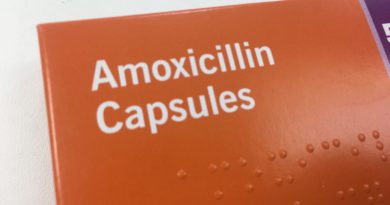Antibiotic Resistance Will Prevent Infection From Being Treated in the Future, Warns Chief Medical Officer
What causes antibiotic resistance?
Antibiotic resistance occurs in two main ways: Firstly, when people are taking antibiotics, but feel better after one or two days and don’t finish the course. Although they feel better, they may not have killed all the bacteria, which means that the bacteria which is left can mutate into a antibiotic resistant strains. The other way in which antibiotic resistance occurs is through patients being given antibiotics for a non-bacterial illness. This is because the patients think that antibiotics will help them, even though antibiotics only kill bacteria. This causes resistance by allowing the other bacteria in the body to develop resistance to the drug. Through both of these methods, the bacteria will spread the resistance it now has by sharing plasmids with other bacteria, as well as reproducing to create a more dangerous antibiotic resistant strain. The bacteria with the drug resistance, should be favoured in natural selection as they have a competitive advantage. When bacteria, become resistant to many antibiotics, they can make a patient’s illness untreatable, for example MRSA, a strain of bacteria which spreads around hospitals, is very difficult to treat because of its multi-drug resistance.
How do antibiotics work?
Antibiotics target a part of the bacteria, which is key to the bacteria’s survival. The most important targets are the bacterial cell wall and the cell membrane, but antibiotics can also target DNA/RNA synthesis, protein synthesis and folic acid metabolism. The antibiotics then disrupt or destroy the area which they target on the bacteria, causing the bacteria to die. Resistance occurs because of this selection pressure which only allows bacteria with resistance to survive. Bacteria become resistant due to 4 major mutations: Target modification, immunity, enzyme action and efflux. Target modification changes the targets on the bacteria through mutation or by releasing enzymes which modify antibiotic targets. Immunity prevents the antibiotic from binding to its target by releasing proteins which bind to the antibiotics or to the targets on the bacteria. Enzyme action, recognises antibiotics and modifies them so that they no longer retain the functional characteristics which enabled them to bind to their targets or to damage the bacteria. Efflux is a process which bacteria employ to remove antibiotics from inside the cell, and is done using protein pumps to expel the antibiotics.
Consequences
When bacteria with antibiotic resistance infects patients, the choice of antibiotics which can be used to treat the infection are limited. This can become problematic in two ways. The doctor or patient might not notice the antibiotic isn’t working and only prescribe an alternative antibiotic once the patients condition has deteriorated further. The other way in which it can be a problem is for bacteria which have multi-drug resistance which makes several groups of antibiotics ineffective. This often means that the patient cannot be treated with known antibiotics.
The Chief Medical Officer has warned the public that the threat of antibiotic resistance is as ‘big a risk as terrorism’ and described it as an ‘apocalyptic scenario’. She also said that in 10-20 years time people will die of routine infections ‘because we have run out of antibiotics’.
What we can do?
This problem is not simply a problem which one country can solve because drug resistant bacteria can easily spread across the globe and create new strains in different areas. The World Health Organization (WHO) is in charge of advising governments to coordinate strategies to tackle resistant bacteria, and they have a Global Strategy for Containment of Antimicrobial Resistance, to help governments take action against antibiotic resistance.
In the UK, the Chief Medical Officer, Dame Sally Davies has highlighted the issue to MPs in her annual report. She also encouraged the government to add the issue to the government’s national risk register of civil emergencies.
Ultimately the problem has two parts: how to prevent antibiotic resistance, and how we can create antibiotics to take the place of those that are useless due to antimicrobial resistance.
We can reduce antibiotic resistance by reducing the use of antibiotics so that they are only used in serious cases. Many hospitals have an ‘Antibiotic Policy’, which provides guidelines to doctors to ensure that antibiotic use is carefully regulated and does exacerbate the antibiotic resistance problem. Another method used to prevent antibiotic resistance is to block the mechanism by which the bacteria become resistant to the drug. E.g. Clavunanic acid can be used as a decoy to stop the bacteria from targeting penicillin by blocking the enzymes the resistant bacteria release.
The process by which new antibiotics are discovered takes a lot of time and is very expensive. The approximate cost of bringing a new antibiotic to market is about £200 million and takes about 10-12 years. Only two new classes of antibiotics have been discovered in the last 35 years, and both are now useless due to antibiotic resistance. Alan Johnson a consultant clinical scientist at the Health Protection Agency (HPA), said ‘what has changed is that the development pipeline is running dry. We don’t have new antibiotics that we can rely on in the immediate future or in the longer term’. This is because big pharmaceutical companies don’t want to develop drugs which are expensive, and take a long time to develop, only to find that drug resistance develops within 2-3 years. The economics behind antibiotic development are poor, emphasized by the fact that only 4 out of the 12 biggest pharmaceutical companies are doing research into new antibiotics. In 2011 Pfizer, the world’s largest drug company closed its antibiotics research center in Connecticut because of the poor economics. Although a new antibiotic may make a billion dollars from when it goes to market and when it becomes obsolete, drug companies focus on medicines that treat chronic conditions, which bring in far greater profits because patients take the drugs for years. Something needs to be done to encourage pharmaceutical companies to create new antibiotics to solve this impending crisis. What do you think should be done?






